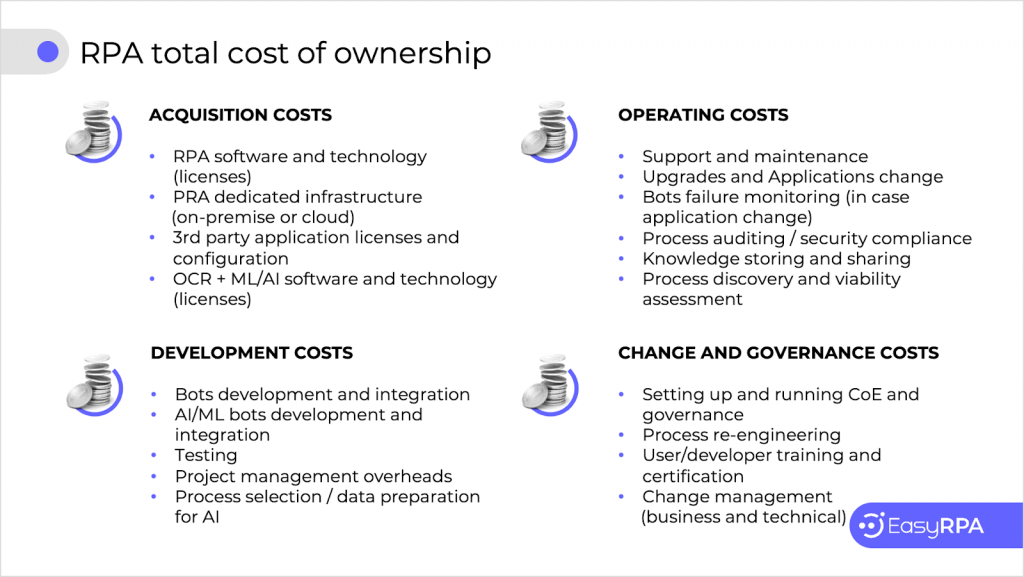Meet Quinn and Riley. They work at Big Company. Big Company is a successful company, much like yours, and they are in the process of choosing a Robotic Process Automation, or RPA, platform.
Quinn is a technical expert and RPA champion. Quinn has overseen the technical side of process automation for several companies before arriving at Big Company. Quinn knows the best ways to use RPA platforms and what potential pitfalls to avoid. Riley is a business practitioner and subject matter expert. Riley has been at Big Company their entire career. An incredible people’s person, Riley is always on the lookout for ways to make work better for the company and employees. Riley and Quinn have been looking to use RPA to reduce costs and increase productivity in addition to improving quality and accuracy across the processes to be automated. It’s near the end of a work day on Friday and Riley has swung by Quinn’s cubicle. They are mid-conversation, discussion of which RPA platform they are going to choose. Let’s drop in, for a bit, on their conversation.
QUINN: “A lot of places are in the business of selling software, so we have to be careful with license fees. There can be even more fees when it comes to upkeep or new development studios and as teams grow, costs grow. I mean, if we’re looking at, say, $5,000 to $10,000 a bot per year, and we end up having a hundred bots, that can be cost prohibitive.”
RILEY: “Yes, and fancier bots can cost even more. We should take some time and look at the big picture, account for what we’ll need down the line. What do you think?”
QUINN: “That’ll be good. It’ll be helpful to make sure everyone’s on the same page with where we’re going. We need to make sure that we can plan accordingly and scope out whether we’ll need AI or ML further down the line, on top of generally scaling our expertise and building our center of excellence as we get savvier with the platform.”
RILEY: “Do we need to worry about anyone being cut?”
QUINN: “Likely, no. But roles might change. If we gradually switch to a pro-dev approach your team can focus on identifying processes to be automated while we worry about all the things you don’t like to worry about.”
RILEY: “Great! So, we’ll plan a bit more, find something without a license fee, and we’ll build out more of a road map.”
QUINN: “That’d be great. We can properly scope out the total cost of services and get going from there.”
RILEY: “Wonderful, we’ll touch base about this first thing on Monday. “
They do touch base on Monday, and that meeting lays the ground for a successful and cost effective implementation of an RPA platform. The platform they chose? EasyRPA. Their bosses love them.
Explanatory Summary
To properly calculate the Total Cost of Ownership (TCO) of an RPA platform, organizations must form a clear idea of how the platform’s adoption will impact profitability in the long run and what they will be requiring of the platform in order to achieve their desired outcome. The peak ROI that a RPA platform can provide occurs when a platform reaches maturity, and it is important to account for the costs that are not always initially apparent.
Costs can be broken down into four main categories.
- Acquisition Costs. Even though HFS Research estimates that license fees represent 25-30% of the total costs for implementing RPA, they lie at the heart of many RPA platforms. These fees can add up, especially when implementing more advanced automations, such as those using Artificial Intelligence and Machine Learning. Commonly, there are per-bot fees along with additional costs for often needed add-ons.
- Operating Costs. These include ongoing support for the projects, maintenance, and the work that goes along with any upgrades. Process discovery and the viability of processes to be automated are included here. There are also the people involved in developing, delivering, and the ongoing support for any given automated process.
- Development Costs. To gain the maximum ROI from an RPA platform certain aspects of your automations need to be adjusted to your needs. Development, testing, and project specific adjustments all use resources. This also accounts for adjustments required to integrate the new automations with any legacied processes at your company.
- Change and Governance. There are costs associated with implementing new platforms in any type of organization. It will take time and resources to set up a Center of Excellence. Your RPA program may create a need for new roles, like change management experts or operational resources for your RPA CoE. Even with the smallest automation, your CoE will typically require five unique positions to function effectively. Building your in-house team can quickly escalate into a high operational cost.
Fig 1. A Breakdown of RPA Total Costs of Ownership

